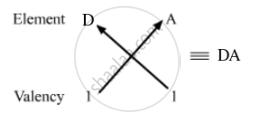Advertisements
Advertisements
प्रश्न
The electrons in the atoms of four elements A, B, C and D are distributed in three shells having 1, 3, 5 and 7 electrons in the outermost shell respectively. State the period in which these elements can be placed in the modern periodic table. Write the electronic configuration of the atoms of A and D and the molecular formula of the compound formed when A and D combine.
उत्तर
| Elements | Valence electrons | Period |
| A | 1 | 3 |
| B | 3 | 3 |
| C | 5 | 3 |
| D | 7 | 3 |
Electronic configuration of A: 1s2 2s2 2p6 3s1
Electronic configuration of D: 1s2 2s2 2p6 3s2 3p5
Molecular formula of the compound formed with A and D:
Atomic number of A = 11
Electronic configuration A = 2,8,1
Number of valence electrons of A = 1
Valency of A = 1
Atomic number of D = 17
Electronic configuration D = 2,8,7
Number of valence electrons of D = 7
Valency of D = 8-7 = 1

So, the formula of the compound formed when elements A and D combine is AD.
APPEARS IN
संबंधित प्रश्न
Rewrite the following statement after correction, if necessary:
The metallic character of elements in a period increases gradually on moving from left to right.
How do atomic structures (electron arrangements) change in a period with increase in atomic numbers from left to right?
In which part of a group would you separately expect the elements to have the greatest metallic character
An element X belong to 3rd periods and group II of the periodic table state:
name of the element,
Write two reasons responsible for late discovery of noble gases ?
Write the electronic configuration of element 17T35.
- What is the group number of T?
- What is the period number of T?
- How many valence electrons are there in an atom of T?
- What is the valency of T?
- Is it a metal or non-metal?
- State number of protons and neutrons in T.
Based on the group valency of element write the molecular formula of the following compound giving justification:
Halide of the elements of group thirteen
Fill in the blanks from the words A to F given below’.
A: Decreases
B: Increases
C: Remains same
D: Increases by one
E: Electropositive
F: Electronegative
Across a period from left to right in the Modern Periodic Table.
No. of electron shells _________; No. of valence electrons __________: Electronegativity increases Character of elements changes from electropositive to ________.
Fill in the blanks from the words A to F given below.
A: Decreases
B: Increases
C: Remains same
D: Increases by one
E: Electropositive
F: Electronegative
Down a group in the Modern Periodic Table.
No. of electron shells __________; No. of valence electrons ________; Electronegativity ________ Character of elements changes from _________ to ____________.
Match the option A and B with the statements (i) and (ii):
| A. metal | (i) The metal that forms two types of ion. |
| B. iron | (ii) An element with electronic configuration 2, 8, 8, 3. |
